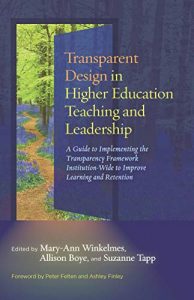What is Transparency?
What is transparency?
James Rhem of the National Teaching and Learning FORUM says that “transparency means letting students in on what they’re being asked to do and why they’re asked to do it– in other words, what they can expect to learn from doing it.”
This idea of transparency attempts to take the guesswork out of learning goals, assignments and classwork, as it seeks to explain the reasoning and purpose behind what is being taught.
What is transparent teaching?
“Transparent teaching and learning methods focus on the subject matter (the what) of a course as much as the why and the how– why teachers choose to manipulate students’ learning experiences as they do, how students acquire and master the course’s important lessons, and how the skills and knowledge they gain will continue to be relevant for students” (Winklemes and Boye 2019).
The goal of Transparency in Learning and Teaching in Higher Ed (TILT Higher Ed) is to make the learning process explicit and equitably accessible for all students.

How can transparency help your students?
Transparent Design is accessible, equitable and an instrument of social justice.
Combining conceptual reasoning with concrete direction to reach goals, users are given clear steps to completing a particular lesson or assignment. This structure takes out the guesswork of the purpose, tasks and how the instruction will be measured and assessed. This allows all students to be able to participate in learning because it seeks to eliminate nuance, hidden meanings and opaque forms of assessment. Instead of students guessing what their instructor’s point is, how to go about their assignment or activity and trying to guess how their instructor will grade them, transparent design seeks to take the guesswork out of the process.
Transparent Design promotes lifelong learning.
This design process can be applied in early childhood education all the way up to doctorate level work, as well as be applied in industry or specialized work. In this way, students can learn the value of transparent lesson planning at any stage of their educational journey. Transparency also clarifies overarching questions and concepts so that students can connect their learning with personalized experiences therefore bridging lessons into meaningful and relevant skills for their own lives.
How can transparency help you as an instructor?
Oftentimes, librarians come into the classroom as “experts” of information literacy, not realizing when our instruction, activities, and assignments are unclear, confusing and full of discipline-specific jargon, acronyms, and expectations. When instructors take the time to clarify what we want students to do, why we want students to do it, and how students can succeed in accomplishing the task, then our instructional becomes accessible and inclusive.
- It is intentional.
- It is inclusive and equitable.
- It is effective.
- It is statistically significant for students studied.
- It boosts student self-awareness and metacognition.
the evaluation or estimation of the nature, quality, or ability of someone or something
a set of abilities requiring individuals to 'recognize when information is needed and have the ability to locate, evaluate, and use effectively the needed information
special words or expressions that are used by a particular profession or group and are difficult for others to understand
awareness and understanding of one’s thinking processes

